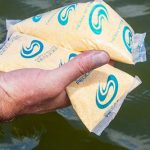Everything done so far has been in the pursuit of two basic goals:
- Create an aerobic environment for optimal waste digestion and water quality
- Provide beneficial bio-enzymes and microbes for wastewater treatment and solids digestion
Now that the equipment has been installed, it must to utilized as part of a program in order to achieve the full benefit of your investment.
Operation of the aeration system
Once the aeration system is installed, it should remain in constant operation 24 hours per day. This is necessary to maintain the dissolved oxygen levels necessary to support the bacteria that treat wastewater. The aeration system equipment itself should require little maintenance. We suggest you check the compressors regularly to make sure they sound right and there are no obstructions around them. Have a look at your lagoons or ponds to make sure you still see all of the bubble plumes from the diffusers and that they look about the same.
Why Add Beneficial Microbes?
Now that you have adequate air going into your lagoons or ponds, you have a great habitat for the bacteria and microbes that treat the wastewater. As we’ve previously described, air is only one of the two goals for an efficient wastewater lagoon treatment system. The other goal is to establish a strong population of the right kind of bacteria in order to adequately treat the wastewater and avoid having the excess nutrients in the lagoons which can cause the growth of weeds and vegetation.
Dosing the Beneficial Microbes
Always follow the guidelines for dosage amount and frequency. If you don’t, your results may be less than optimal and you will be wasting product. There will typically be a building period in the beginning where you will be using more bio-enzymes than normal. Once this building period is complete, you will have a sufficient population of bacteria and will only need to dose enough enzymes to maintain the system.
- If you have an aeration system installed, make sure it is operating correctly and turn it on.
- Throw the water-soluble bag of enzymes in the middle of the lagoon or pond. If using enzymes in pellet form, add the pellets in the area where they need to go.
- Follow the dosage schedule exactly and add additional doses as required.
- Maintain your aeration system to sustain adequate DO levels.
See our Dosing Rate page for guidelines for how much bio-enzymes to use.
- Our Bio-Enzymes come in water soluble bags and do not require special handling.
- The bag will float temporarily before it dissolves and sinks.
How soon do our customers see results?
Many of our customers see results within hours. The results include clearer water, less odor and bluer water color. Typically, full rehabilitation occurs over four weeks or so.
Possible Adverse Conditions That Can Occur
Depending on your particular situation, it is possible that some temporary adverse effects will occur. For instance, we have seen situations with lagoons and ponds that have an old thick sludge blanket on the bottom. These lagoons and ponds, when properly mixed for the first time in years, release toxins trapped in the sludge blanket. When this happens, the water turns red which is a sign that the beneficial bacteria in the pond is dead or dying. In these cases, a continued high dosage of microbes will correct the problem over the course of a week or so. Other conditions can include an increase in floating sludge and an increase in odor. Please keep in mind that these conditions are temporary and reflect the fact that you are churning up all the junk that has been lurking in your lagoon or pond for years. This is actually a good sign!

“Red is Dead” as they say. This wastewater lagoon had a thick layer of old sludge on the bottom. The sludge was broken up with the new, sub-surface aeration system. Unfortunately, the bacteria in the lagoon was killed by whatever toxic substance was is the sludge. With continued aeration and extra doses of microbes, this lagoon will be in good shape soon.
If you have concerns with these or other conditions during operation of your rehabilitating wastewater lagoon or pond, please don’t hesitate to call us! Our service does not end when our truck pulls out of your driveway. We are invested in the success of our clients.
That’s the end of part 4. If you have any more questions about equipment, our sales/installation process, microbes or your situation, please give Randy Sorenson a call at 303-520-4961.


